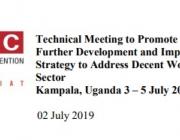To conclude the year 2023, the Observatory for Monitoring Tobacco Industry Strategies at the Center for Tobacco and Health Studies of Fiocruz has selected the 10 most relevant strategies of tobacco industry interference in public policies in Brazil.
100 specialists in nicotine science, policy and practice have come together to call on the 182 parties (countries) to the Framework Convention on Tobacco Control to take a more positive stance on tobacco harm reduction. The letter pushes back against WHO’s misguided and unscientific drive for prohibition or excessive regulation and taxation of vaping products, heated and smokeless tobacco products, and novel oral nicotine products, such as pouches.
ONE hundred specialists call for WHO to change its hostile stance on tobacco harm reduction - new letter to FCTC delegates published. The Counterfactual, Inglaterra, 18 out 2021. Disponível em: https://clivebates.com/one-hundred-specialists-call-for-who-to-change-st.... Acesso em: 1 jul 2024.

"The WHO Framework Convention on Tobacco Control (FCTC) was: 1 negotiated under the WHO Constitutional Mandate; 2 becoming the first convention with a modern structure with objectives in the field of Public Health, but also addressing the social, economic and environmental impact of tobacco. It currently covers more than 90 percent of the global population. It is an evidence-based treaty addressing both the supply and demand of tobacco products and reaffirms the right of all people to the highest standard of health. It guides and informs the global tobacco control agenda and is a legally binding instrument."
DECLARAÇÃO da Secretaria da Convenção-Quadro da OMS para o Controle do Tabaco e o Protocolo para Eliminar o Comércio Ilícito de Produtos de Tabaco. Secretariado da Convenção-Quadro para o Controle do Tabaco, Uganda, 2 jul. 2019.
Objective: To measure the implementation of WHO Framework Convention on Tobacco Control (FCTC) Article 5.3 at country level using a new Tobacco Industry Interference Index and to report initial results using this index in seven Southeast Asian countries.
Methods: Score sheet based on WHO FCTC Article 5.3 Guidelines sent to correspondents in seven Southeast Asian countries, using a scoring system designed with the help of tobacco control experts and validated through focused group discussions.
Results: The seven countries ranked from the lowest level of interference to the highest are Brunei, Thailand, Lao PDR, Cambodia, Philippines, Malaysia and Indonesia. Countries that face high levels of unnecessary interaction with the tobacco industry also face high levels of tobacco industry influence in policy development. Most governments do not allow any tobacco industry representatives on their delegation to sessions of the Conference of the Parties or its subsidiary bodies nor accept their sponsorship for delegates, but most governments still accept or endorse offers of assistance from the tobacco industry in implementing tobacco control policies. Most governments also receive tobacco industry contributions (monetary or in kind) or endorse industry corporate social responsibility activities. Governments do not have a procedure for disclosing interactions with the tobacco industry, but Lao PDR, Philippines and Thailand have instituted measures to prevent or reduce industry interference.
Conclusions: This Tobacco Industry Interference Index, based on the WHO FCTC Article 5.3 Guidelines, is a useful advocacy tool for identifying both progress and gaps in national efforts at implementing WHO FCTC Article 5.3.
ASSUNTA, M.; DOROTHEO, E. U. SEATCA Tobacco Industry Interference Index: a tool for measuring implementation of WHO Framework Convention on Tobacco Control Article 5.3. Tobacco Control, Reino Unido, v. 25, n. 3, p. 313–318, maio 2016.